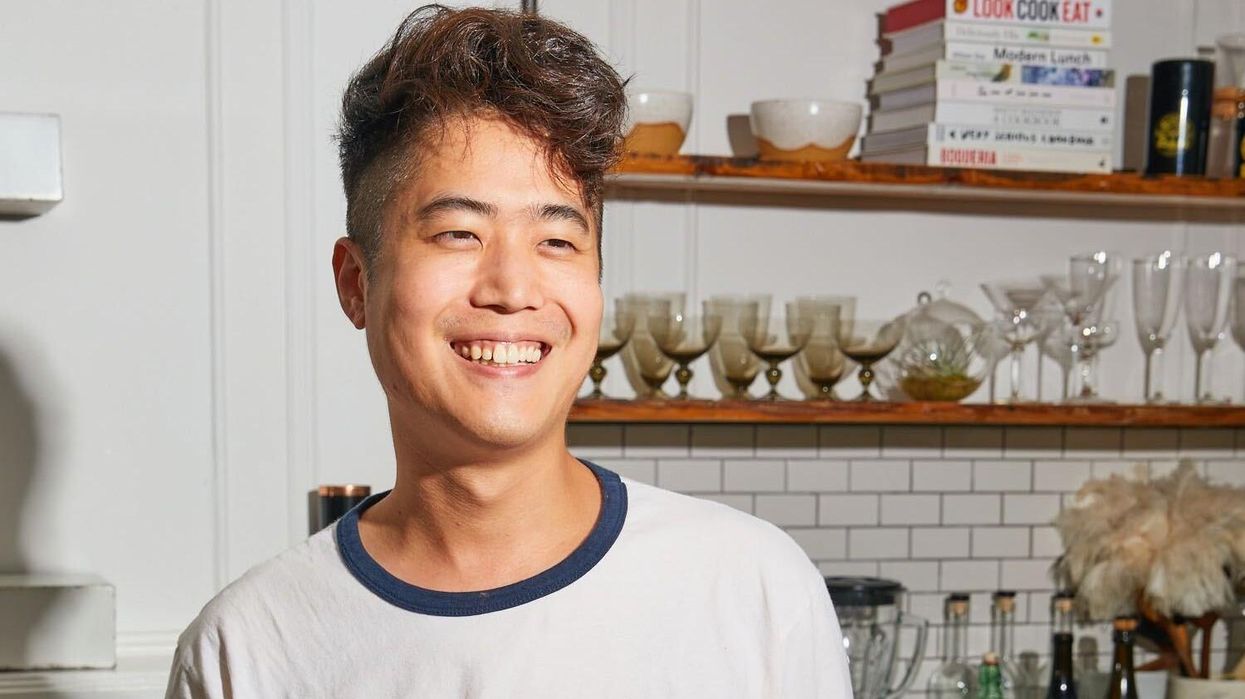
When Eric Kim moved to New York in 2009, he says it was hard to find good Korean food. In the years since, many fantastic restaurants have opened. He’s also shifted his own grading system. A Korean American himself, the New York Times cooking columnist and author of Korean American: Food That Tastes Like Home and "Eric Kim’s Essential Korean Recipes" was admittedly searching for flavors reminiscent of his own experience—that of the Korean American community in Atlanta in the ‘90s and early 2000s. Now, Kim finds pleasure in discovering a chef’s story through the nuances of their own cultivated menu.
Growing up in Atlanta, Kim describes local Korean restaurants as “nexuses for the community to gather” for birthday parties or celebrations. Now, a Korean restaurant functions more so as a vehicle to broaden his own palate, while simultaneously enjoying an unavoidable and much appreciated wave of nostalgia. “It's a really wonderful experience to get to eat someone's food, and you can taste how authentic it is to them,” he says. “Whenever people ask me the kind of food I like to eat, it's food that tastes honest. To me, that food is by people who are really pulling from their own biographies.”
Though each restaurant is different, Kim has fashioned a quick litmus test to gauge anticipation in the perspective entrée. If the restaurant is serving their food in a more traditional style with Banchan (a group of side dishes that accompany your meal) and kimchi, he’ll gauge his interest through the quality of those accoutrements. “If those taste really homemade and well-seasoned, that makes me very excited about the meal.”
When it comes to specific menus, Kim looks for a sense of voice, no matter the culinary dialect. “It's also important to point out that these restaurants who are straying from what is considered traditional, they're not making fusion food by popping a bulgogi onto a slider,” he explains. “They're really pulling from their own honest experiences. I think that's the difference between the Korean food that's happening now in restaurants than maybe [those of] 10 years ago.” If an exciting menu ushers him through the door, a low noise level keeps him seated. “I have very sensitive ears,” he laughs. Continue scrolling to discover Kim's five favorite Korean restaurants in Manhattan, and what he orders at each.
“Cho Dang Gol is the restaurant I tell everyone about. Some Koreans tell me that I shouldn't because it's sort of like sharing a secret, making other people aware of this gift that you don't want to be diluted. Ruth Reichl wrote about it in 1998 for the New York Times so it's been around, but what's really incredible about it is that it's gotten better. Over 10 years ago, I moved to New York and had it, and just was like, ‘Wow, this is the only restaurant that actually tastes like my mom's cooking.'
[As for what to order], I would definitely get the omelet. It's called Gyeran-mari. It comes with a gorgeous green sauce. It's a green tea mayo. It's just very savory, but also creamy because there's cod roe. It sounds interesting, but cod roe is used to season a lot of things. It's almost like bottarga in Italian traditions. This omelet is just so perfectly soft-set. It's such a good bite of food. I'm happy with just that, but my go-to order is kimchi biji jjigae. People know kimchi jjigae, which is kimchi stew. Biji is ground-up soybeans. It's sort of like tofu if it were deconstructed. It's almost like a creamy stew, but the creaminess comes from soybeans, not cream. [Then there’s] huge chunks of really soft pork in it. The bulgogi stew is very comforting. Budae jjigae is really fun to order if you're with a crowd. It's just a very hearty stew that has lots of delicious things in it and noodles. I like all the jeons; they're kind of like savory pancakes. I think the reason Korean savory pancakes are so good is that they really rely on the vegetables and meat that are inside. They almost cook up like fritters.
It's hard to come to this restaurant alone because you need a lot of people to go and order many things so that everyone can share. I love this restaurant because you can order anything, really, and it'll be very good. It's just very special. It's such an authentic recommendation from me because I really, really believe in that place.”
“Shanghai Mong is very great. The novelist Min Jin Lee wrote this great piece about the relationship between K-town restaurants and their customers during the start of the pandemic. She writes about it in such a beautiful way. I knew from her descriptions and from the photos that it was Shanghai Mong. It's my favorite place to get jajangmyeon—this very popular noodle dish that’s a Korean interpretation of Chinese food. It's comfort food. You associate it with delivery and takeout. I like Shanghai Mong’s because their noodles are this deep, golden yellow. You can see the egg in it—it's a very good noodle. The sauce is really good and also loaded with a lot of pork belly. I feel like that's a good sign when they're generous with the pork belly. The jjajangmyeon there is my favorite. It's been my favorite since I moved to New York.
It's always a difficult decision whether you're going to have jjajangmyeon or jjamppong. It's like a spicy seafood soup. It's really reminiscent of a bouillabaisse or cioppino. It has those flavors, but it's really, incredibly creamy. There's no cream, but it's so rich. You can get a bowl that has a divot in the middle, so that one side has the jjajangmyeon and one side has the jjamppong. They [also] sell just the broth as an appetizer portion. I love getting jjajangmyeon with the soup appetizer version of the jjamppong broth. That goes great with shrimp fried rice. The shrimp fried rice at Shanghai Mong is very eggy and has a lot of blonde tastes versus a soy-saucy brown taste. It's kind of like salt is the flavoring versus soy sauce, which I really enjoy. The fried dumplings—that’s sort of a classic order for me. This place is where you go to really pig out with your friends.”
“Her Name is Han is great for lunch specials. They have a lot of little boxed dosirak, [a Korean term for lunchbox], types of meals. They're these little boxes that have a variety, and it's really solid food. It's a great lunch spot. They have cute cocktails and stuff. I like that place.”
“Mokbar is in Chelsea Market right now, and it's run by a chef named Esther Choi. She's a friend of mine, but before she was my friend, I always liked her food. You could taste her food and know that she cooked it. That's what I mean about chefs who have a voice. Her food has a perspective, and it tastes really expertly seasoned. I don't know how to explain it, but it's the kind of food that is different from other people's food. She does Korean-inspired ramen dishes. She takes classic Korean dishes and ramen-izes them, basically. It's really genius. It's a nice taste of Korea. She's a really creative chef, as well. I love her food.”
“The last one is Soju Haus. It's where the kids go late at night after a night of karaoke, and they need some sustenance to sop up the soju. If you want more soju, of course, you go there too. I went there after my book launch. We had a really lovely meal here. The food is really nuanced. It's surprisingly good. If all the restaurants before this are very Korean American or were sort of like the food from the '80s that was brought over by those immigrants, Soju Haus feels like it came straight from Seoul in that the bar food is just so expertly done. It's really special bar food.
There are these really huge clams that you can get in a broth (the clear clam soup with flat noodles). I just love the idea of being drunk with friends and sharing these clams—it's such a highbrow thing to be eating. It's a very clean broth so that you really just taste the clams as they are, which is really special and very Korean. Korea's a peninsula. People don't realize the importance of seafood in the cuisine. It's not just meat.”




